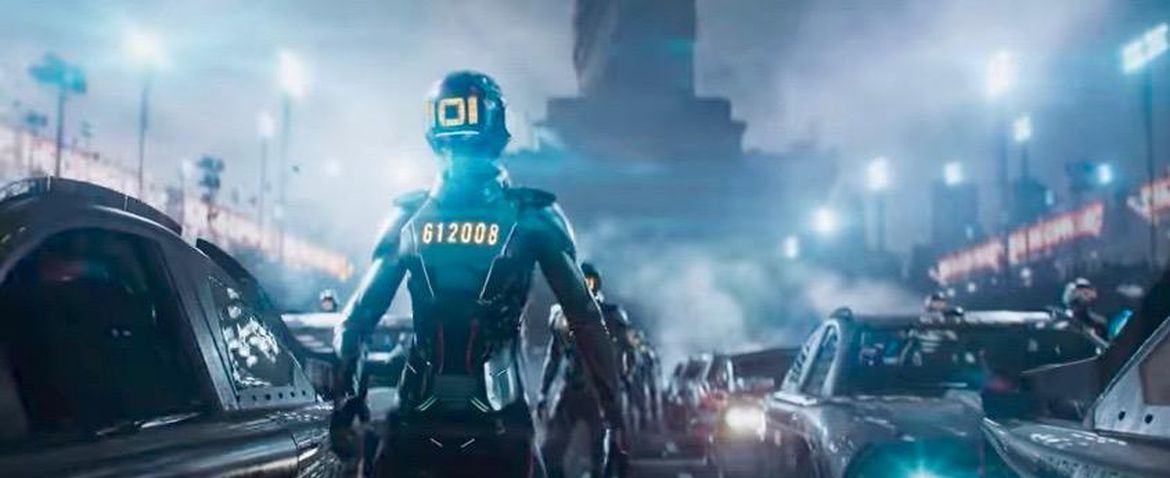
Robohub.org
3 initial thoughts on Ready Player One

The long-anticipated, Steven Spielberg-helmed Ready Player One has just been released in UK cinemas this week, and as a film of obvious interest to DreamingRobots and Cyberselves everywhere, we went along to see what the Maestro of the Blockbuster has done with Ernest Cline’s 2011 novel (which the author himself helped to adapt to the screen).
We went in with a lot of questions, not least of which included:
- How would Cline & Spielberg update the material? (in terms of VR technology, 2011 is so… 2011. )
- How would the film engage with the modern politics of the Internet and gaming?
- How would Spielberg use the most up-to-date cinematic techniques and effects to enhance the film? (would this be another game changer?)
- What would the film have to say about our future? the future of gaming? of our interconnectedness? social media? what would the film have to say about the future of humanity itself?
A one-time viewing and a next-day review are, of course, too early to answer such big questions with any certainty. Fortunately, however you feel about the film itself, it will reward many multiple viewings on DVD as even the most unsatisfied viewer won’t be able to resist pausing the action frame-by-frame to catch all the references and fleeting glimpses of their favourite video game characters of the past.
But for now, here are 3 initial responses for discussion/debate:
1. Ready Player One is a morality tale about corporate power and the Internet
Cline’s original novel was very much a paean to plucky independent gamers resisting the ruthless greed and world-conquering ambition of the Corporate Villain (while simultaneously, strangely, lionising the richest and most world-conquering of them all, James Halliday, the Gates-Jobs figure transformed here into the benevolent deus ex machina that built his trillions on creating the OASIS). The film remains true to Cline’s vision, and perhaps even heightens this black-and-white, goodie-versus-baddie (IOI), with a brilliantly cast Ben (‘Commander Krennic’) Mendelsohn and a tragically under-used Hannah John-Kamen heading an army of faceless corporate infantry.
But while this wouldn’t have been at the forefront of Cline’s thinking in 2011, it is impossible to watch this film now, today, and not think of the erosion of net neutrality that was set in motion by the FCC’s December 2017 decision and, more recently, the exposure of Facebook’s data breach by Cambridge Analytica, which has finally woken more people up to the reality of mass surveillance and what personal data corporate giants have and how it might be misused.
There is little chance that Spielberg and Cline had either of these potential dangers in mind when the film went into production. And such issues shouldn’t be vastly oversimplified in real journalism, but storytelling is always a good way to make people understand complex issues and motivate them to action, and if RPO‘s simple story of goodies and baddies can become a cultural rallying-point for the dangerous mix of unchecked capitalism and our social interconnectedness, then that is a Good Thing
2. Spielberg’s film goes a certain way into correcting some of the problems of the original novel (though could have gone further).
Through no real fault of the author, opinions on Cline’s once much-lauded book were revised, post-#gamergate, and what was once seen as an innocent tale of a young (definitely boy) geek’s nostalgic travels from social outsider to saviour of the world (cf. also Cline’s Armada) came to be seen by some instead as a symptom of everything behind the vile misogyny of white male gamers, backlashing out at anyone that didn’t see how they were the best and most privileged of all people on this earth.

Let’s be clear: the gender politics in the film are far from ideal. How is it, for example, notes another reviewer, that two of the main female protagonists are so ignorant of basic Halliday-lore? And there is still a bit too much of White Boy Champion of the World in even this version of Cline’s tale. However, having said that, other critics, too, have noticed a much-improved gender consciousness in the film.
But what is clear from Spielberg’s offering is that women are as much a part of gaming culture as men, and have every right to occupy the same space, and anyone who thinks otherwise can be gone. Without wanting to give anything away, it is enough to note that Art3mis is a legend in the OASIS, a skilled gamer that Parzifal worships, and that one of the OASIS’s best designers/builders (or programmer) is also a woman. Outside of the VR world, the real women behind the avatars are among the best-drawn characters (albeit in a film not overburdened with character depth, but then this is a Spielberg popcorn speciality, not one of his Oscar worthies). Both Olivia Cooke and Lena Waithe are given space to live and to be (the former, in particular, being a much more interesting protagonist the poor Wade Watts, who really is little more than his avatar), and as previously mentioned, John-Kamen is a much more frightening villain than Mendelsohn’s corporate puppet.
This film shouldn’t be heralded as a feminist triumph or a shining example of post-Weinstein Hollywood, but it is a step in the right direction, and it might mean a few more people can forgive Cline for the white-boy wank-fest that they perceive (not without some good reason) the original novel to be.
3. Despite some nods to progressive politics, the film holds deeply conservative views on human nature.
A big attraction of the novel and the excitement of the film, for DreamingRobots and Cyberselves, was the way the novel created worlds in a new reality, and explored the ideas of what humans could become in such spaces no longer bound by the physical limitations of our birth. It’s what we’re looking at with our experiments in VR and teleoperative technologies, and we ask the questions: what happens to human beings when we can be transformed by such technologies? What might our posthuman future look like?
The film does not ask these questions. In this respect, again, the film does not deviate from the original novel. The novel, for all its creativity in imagining such virtual realities, before they were fully realised in real-world technology, was still very much about recognisably human worlds. The film actually regresses to a vision of human experience where the worlds of flesh-reality and virtual-reality are more clearly demarcated. In the book, there was at least a certain bleeding between these two worlds, as events in the virtual world could have consequences in the real world and vice versa. In the film, however, only real-world events have impact on the virtual world. Events in the virtual world do not impact upon the real, and the two storylines, the two battles between goodies and baddies in the virtual and real worlds, are clearly separate. (Highlighted by the fact that there are distinct villains for each location: John-Kamen’s F’Nale Zandor never enters the virtual world, while T.J. Miller’s I-R0k exists only in the virtual. Only Mendelsohn’s Sorrento is the only villain crossing that boundary.)

Spielberg’s vision of 2045 is clearly dystopian: you can see it in the ‘Stacks’, where so many impoverished are forced to live, the utter dominance of mega-corporations, and the inability (or unwillingness) of the state to provide for or protect its citizens. But while so many of the citizens of 2045 take refuge in the paradise that is the OASIS, Spielberg makes it clear that this world is merely a symptom of the dystopian world of the flesh. The opium of these alienated masses, in fact, amplifies the miserable situation of these people. We’re supposed to pity the people we see, caged in their headsets, who can’t play tennis on a real tennis court, or dance in a real nightclub, or find love… wherever real people find love.
This is clear at the film’s conclusion, but as we don’t want to give away spoilers, we’ll leave it for you to see for yourselves. But what is evident throughout is that the virtual world should only be a place where gamers go to play – it is not a place where humans can live. And it is only in the world of flesh that humans can really, successfully exist. Again, this is evident in Cline’s novel: ‘That was when I realized, as terrifying and painful as reality can be, it’s also the only place where you can find true happiness. Because reality is real.’
As one reviewer has so succinctly put it:
But here’s the thing. Ready Player One is a tragedy. What seems like a fun adventure movie is actually a horror movie with a lot to say about the way we live now, the way we might live in the future, and the pitfalls and perils of loving video games too much. This is Spielberg reflecting on the culture he helped create, and telling the audience he made mistakes.
The only objection I have to the above quotation is the idea that the film has a lot to say about the way we might live in the future. Because our future will most certainly be posthuman, and this film cannot shake its humanist origins, and its deeply conservative understandings of how we might use technology. In this film, that posthuman being, and the technology that enables it, is as much of a threat to human life as a Great White shark or rampaging dinosaurs.
The film, therefore, cannot at all accommodate what will be the most imperative issues for human beings in the very near future. Such a binary understanding comes straight from the classic humanist guidebook: fantasy is fine, technology can be fun, but what’s real is what’s real, and what is human is human. That meddling in human’s true nature can never bring us happiness, and it is only by eschewing anything external to our true nature can we be truly happy, or truly human, are the usual humanist scaremongering about technology that we’ve seen time and again, since Mary Shelley’s classic Frankenstein did so much to create our present fantasies.
Nevermind that such a worldview ignores the fact that there has never been such a creature, a human being unimpacted by technology. Nevermind, too, that Spielberg’s entire cinematic oeuvre is fantastically, stubbornly, deeply and, sometimes, beautifully humanist (even when, or perhaps especially when, he’s telling stories about big fish or aliens). It is nevertheless a disappointment that such an opportunity, that such a potentially transformative film about the future and how we can be re-shaped by technology, plays it safe and retreats to a nostalgia for a kind of human being that is increasingly becoming obsolete. It would have been nice if Ready Player One was a great film about posthumanism, addressing the vital issues about technology that we are increasingly facing. But alas… Perhaps we should dive back into Spielberg’s catalogue and watch A.I.

Having said that, Ready Player One is a fun film and we will be taking our children to see it ironically, perhaps, for the message that games are fun but sometimes yes, you do need to turn them off. (It is definitely worth its 12 Certificate, though, so parents of younger children be warned. And of course we’ll buy it on DVD, to catch another glimpse of our favourite gaming characters.)
(Which films do you think better address our posthuman future? Suggestions below, please!)




